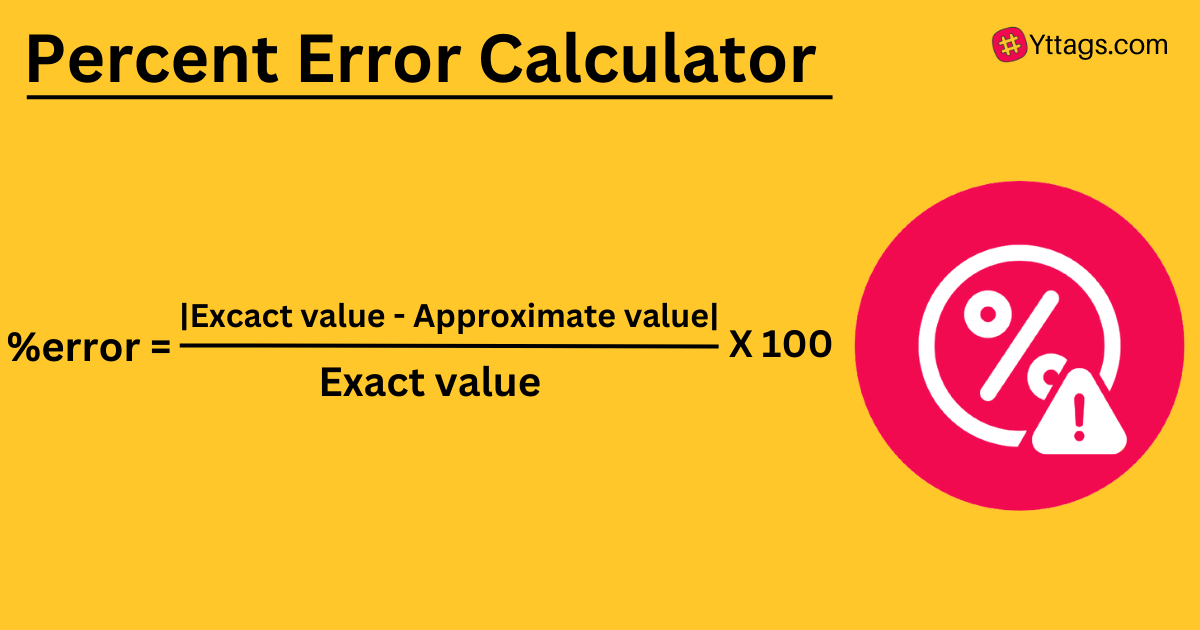Percent Error Calculator
The percent error calculator finds the relative error between the observed and true values and the true value of a measurements,
plus learn the percent error formula, with examples.
Average Rating: Tool Views: 185
How to use this Percent Error Calculator Tool?
In the world of mathematics, science, and engineering, precision is paramount. Whether calculating experimental results, estimating quantities, or analyzing data, it's essential to have tools that can provide accurate measurements. One such tool is the Percent Error Calculator. This article will delve into what a Percent Error Calculator is, how it works, and why it's crucial in various fields.
What is Percent Error?
Percent error is a measurement of the accuracy of an estimated or experimental value compared to an accepted or known value. It is expressed as a percentage and can be calculated using the formula:
Percent error calculator online - free and easy to use. ➤ Calculate the percentage error of an observation relative ot a known or estimated true value (theoretical value). Calculate percentage error relative to a true or theoretical value. Percent error formula, what is percent error and how it relates to relative error and absolute error, and practicle calculation examples. Relative error calculator in percentages.
Percent Error Formula: ((True Value-observed Value)/True value)× 100
Calculating Percent Error
The percentage error calculation formula is as follows:
Percent error = (Estimated value - Actual value) / Actual value × 100% (in absolute value)
The result of this calculation provides insight into the precision of the measurement or estimation. A percent error of zero indicates a perfect match between the experimental and accepted values, while a positive or negative percent error indicates overestimation or underestimation, respectively.
How Does the Percent Error Calculator Work?
A Percent Error Calculator automates the process of calculating percent error. Users input the experimental and accepted values into the calculator, and it computes the percent error using the formula mentioned above. The calculator then displays the result as a percentage, along with an indication of whether the error was positive or negative.
Importance of Percent Error Calculator
The Percent Error Calculator is crucial for several reasons:
-
Accuracy in Scientific Research: In fields like chemistry, physics, and biology, accurate measurements are essential for drawing valid conclusions from experiments. The Percent Error Calculator helps researchers assess the accuracy of their results and make any necessary adjustments.
-
Quality Control in Manufacturing: In industries that rely on precise measurements, such as manufacturing and engineering, the Percent Error Calculator can help ensure that products meet quality standards.
-
Educational Tool: In educational settings, the Percent Error Calculator is a valuable learning tool that helps students understand the concept of error and its implications in measurement.
Limitations of Percent Error
While the Percent Error Calculator is a useful tool, it's essential to understand its limitations. Percent error does not provide information about the direction of the error (overestimation or underestimation) or the distribution of errors in a dataset. Additionally, percent error can be misleading if the accepted value is not accurate or if the experimental value has significant uncertainty.
How to use Yttags's Percent Error Calculator?
- Step 1: Select the Tool

- Step 2: Enter The Approximated/measured value & Exact/actual value And Click On Calculate Button.

- Step 3: Check Your Percent Error Calculator Result

Conclusion
The Percent Error Calculator is a vital tool in scientific research, engineering, and education. It provides a straightforward way to assess the accuracy of measurements and estimations, helping researchers and professionals make informed decisions. As technology continues to advance, we can expect to see more sophisticated tools that further enhance our ability to measure and analyze data accurately.
